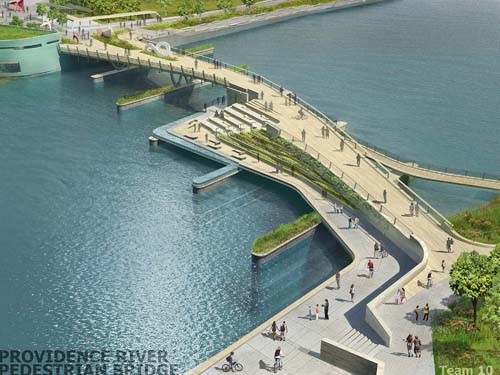
Since the old Interstate-195 overpass was demolished this year, the slice of Providence that emerged from the old highway’s shadow has become a somewhat tranquil, park-like place.
But design work on the string of real parks and a river-spanning pedestrian bridge in the old highway’s footsteps that officials hope will repopulate and re-energize the centrally located area are now on hold.
In one of its first significant acts since forming this fall, the state I-195 District Commission, charged with overseeing the redevelopment of the former highway lands, has halted advanced design work on the parks in order to review their size and shape.
“They’ve asked for the designing of the parks to be paused until they have a chance to re-evaluate the size and scope,” said David Freeman, head of design for the Maguire Group, the engineering firm working on the former highway land for the R.I. Department of Transportation. “Everything is on hold.”
Work on the park and bridge design has been going on for years and intensely so this past summer, so Freeman acknowledged that even the hint that the commission will order everyone back to the drawing board is nerve-wracking.
The current park plan calls for a combined 17.1 acres of new park space on both sides of the river, 2.4 acres more than federal approval of the highway-relocation project requires.
The possibility of shifting some or all of those 2.4 acres to revenue and job-producing development was one of the reasons commission members said they wanted to review the design.
Right now the designs for both the parks and the bridge are 10 percent complete, a level of detail that does not include precise drawings or finished designs for elements such as stormwater control.
Whether the “thoughtful pause,” the commission called for will substantially delay or change the parks that will ultimately be built along the river is difficult to predict.
Commission Chairman Colin Kane said he could not estimate how long the review of the park plans will take or how significant any changes to the designs will be.
“We just don’t know,” Kane said. “Honestly, radical change is a possibility, but I don’t think you will see radical change. The commission is not anti-park, but the development is not driven by the park.”
“On a priority basis, the public spaces are very important, but even more important is understanding the environmental aspects,” Kane said. “Some level of public space will happen, but does the commission consider that the No. 1 priority?”
The one part of the highway-redevelopment plan that the I-195 District Commission does not have jurisdiction over is the pedestrian bridge, which is controlled by the state transportation department.
But because both ends of the bridge will land in the parks, work on the bridge has been effectively frozen out of concern those landing areas will change.
Over the summer, while the I-195-District Commission was being created, designers from the Maguire Group and inFORM studio, the Detroit firm that won an international competition to design the bridge, have been tweaking the bridge plans to make them less expensive.
“It has been given a diet since the competition,” Freeman said. “It is a little bit narrower than it used to be. Some things have been refined, but the design intent is still there.”
Distinctive features of the design like the terraced slope from the upper ramp to a lower ramp, designed to be used as a gathering and performance space, remain.
That public space, which designers envisioned making the bridge a destination as well as a thoroughfare, was one of the main features that distinguished the inFORM design from other finalists.
Perhaps the most controversial aspect of the inFORM bridge plan, a water-level bridge restaurant, has been at least a partial victim of the slimming-down process.
“There is a gathering space, but the café itself, in terms of cost, proved to be too much,” Freeman said. “There is a place where you can have an event that could be catered, but there is no kitchen on the bridge.”
Michael Guthrie, a principal at inFORM, said the recent changes to the bridge design have not watered down the vision that attracted people to his firm’s bridge concept in the first place.
“There were definitely opportunities to slim it down and keep the concept,” Guthrie said. “It was about going through more of a refinement phase, but keeping the originality. When we showed it to people with the city, some didn’t even know that there had been changes.”
As for the café, Guthrie said a space remains to prepare food on the bridge, but the expensive water utilities that would come with a traditional restaurant will likely be in a land-side building in the park.
Guthrie said the narrowing of the design, from 27,000-square-feet to 20,500-square feet, is mostly on the west side of the bridge by the wildflower gardens and will make the structure align better with the existing support piers. The “busker terrace” and gathering space is on the east side of the bridge.
Not originally a part of the highway-relocation project, the pedestrian-bridge plan came from a Rhode Island School of Design student, who suggested leaving the five piers that held up the old bridge and using the roughly $2 million it would cost to remove them toward building a new span on them.
The idea caught on instantly with planners excited that the bridge would help not only bring life to the riverfront but connect new development in the evolving Knowledge District with downtown, the East Side and South Providence.
To choose a design, the city formed a bridge advisory committee composed of officials, experts, academics and civic-group leaders.
Informed by comments gathered by an online public forum, the advisory committee reduced 47 applicants to a field of 11 who were asked to submit bridge designs.
Ultimately, the destination elements of the inFORM design won out over what was a simpler and probably less-expensive plan from Studio Providence.
Coincidentally, as the bridge and park plans were being put on hold, Studio Providence in December was honored by the American Institute of Architects Rhode Island chapter for the passed-over bridge design.
“Basically, the (bridge) that was chosen was a larger scale, grander scheme, the one that had more opportunities to have activities, business, a restaurant, vendors and make it more of a destination,” said AIA Rhode Island President-elect Michael Warner, who served on the Providence pedestrian-bridge advisory committee that picked the two finalists. “The Studio Providence design was, in my opinion, the more aesthetically attractive but didn’t have the opportunity for a destination spot.”
While he hasn’t seen the most recent bridge design, Warner said he would be concerned if cost-cutting removes too many of the destination elements or significantly reduces the size of the inFORM design
Regardless of what the final design looks like, most people involved with the bridge and parks are now most interested in making sure the projects get done.
City and state officials had been hoping to fund the project through a federal Transportation Investment Generating Economic Recovery, or TIGER, grant, but recently learned that for the second straight year they have been turned down.
Bonnie Nickerson, Providence’s director of long-range planning, said the source of the remaining money to finish the bridge is still up in the air.
As for how long the pause in design work on the parks and bridge might last, Freeman said he got the impression it would take two to three months, but couldn’t really predict what the I-195 District Commission will do once it starts reviewing the plans.
“It all depends on if they start from scratch,” Freeman said. •












